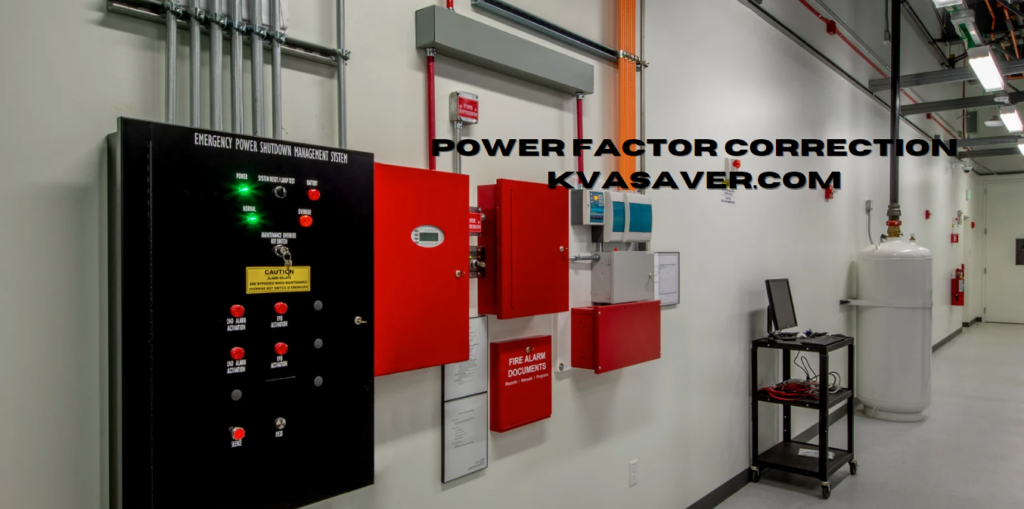Introduction: Power Factor Correction Kvasaver.com
Power factor correction (PFC) is a critical aspect of modern electrical engineering that helps optimize the efficiency of electrical systems. At its core, PFC involves adjusting the power factor of an electrical system to improve its efficiency and performance.
One notable player in this field is Kvasaver.com, a platform dedicated to providing solutions for power factor correction. This article will delve into the intricacies of power factor correction, explore why it is essential, and offer guidance on designing an effective PFC system using insights from Kvasaver.com.
What is Power Factor Correction?
Definition and Basics
Power factor correction is a technique used to improve the power factor of an electrical system. The power factor (PF) is a measure of how effectively electrical power is being converted into useful work output. It is defined as the ratio of real power (measured in watts) to apparent power (measured in volt-amperes). A power factor of 1 (or 100%) indicates that all the power supplied is being used effectively, while a lower power factor indicates inefficiency.
Why Power Factor Matters
- Energy Efficiency: A low power factor indicates that a significant portion of the energy supplied is not being utilized effectively. By correcting the power factor, energy efficiency is improved, leading to reduced energy consumption and lower electricity bills.
- Reduced Losses: Poor power factor can lead to increased losses in electrical distribution systems. These losses manifest as heat in electrical components, which can reduce their lifespan and increase maintenance costs.
- Regulatory Compliance: Many regions have regulations requiring businesses to maintain a certain power factor. Non-compliance can result in penalties and increased costs.
How Power Factor Correction Works
Reactive Power and Power Factor
Power factor correction involves addressing reactive power, which is the power that does no useful work but is necessary to maintain the voltage levels in an electrical system. Reactive power is measured in volt-amperes reactive (VAR). A low power factor is often due to the presence of inductive loads, such as motors and transformers, which consume reactive power.
Methods of Power Factor Correction
- Capacitor Banks: Capacitors are commonly used to correct power factor. They provide reactive power compensation, reducing the amount of reactive power drawn from the supply. Capacitor banks can be installed at various points in the electrical system, including the load side or the supply side.
- Synchronous Condensers: These are rotating machines that provide reactive power compensation. They are more complex and expensive than capacitors but are useful in systems requiring dynamic power factor correction.
- Phase Advancers: Used primarily for induction motors, phase advancers help improve the power factor by reducing the lagging reactive power.
- Automatic Power Factor Controllers: These devices automatically adjust the capacitor banks or other PFC equipment to maintain the desired power factor.
Why Power Factor Correction is Needed
Economic Benefits
Improving the power factor leads to significant economic benefits. By reducing reactive power and increasing the efficiency of the electrical system, businesses can lower their electricity bills. Additionally, a higher power factor can reduce the size of transformers and conductors needed for the same load, leading to cost savings in infrastructure.
Operational Efficiency
Power factor correction enhances the operational efficiency of electrical systems. It minimizes energy losses, reduces the load on generators and transformers, and improves voltage stability. This leads to better performance and reliability of electrical equipment.
Environmental Impact
By improving energy efficiency, power factor correction contributes to reducing the overall energy consumption of a system. This, in turn, helps decrease greenhouse gas emissions and supports environmental sustainability.
Designing a Power Factor Correction System
Assessing the System
Before implementing power factor correction, it is crucial to assess the existing electrical system. This involves:
- Measuring the Current Power Factor: Determine the current power factor of the system using power factor meters or analysis software.
- Identifying Reactive Loads: Identify the loads contributing to the reactive power demand. This includes motors, transformers, and other inductive devices.
- Calculating the Required Correction: Calculate the amount of reactive power compensation needed to achieve the desired power factor. This is typically expressed in kVAR (kilovolt-amperes reactive).
Selecting the Right Equipment
Based on the assessment, select the appropriate power factor correction equipment. Consider factors such as:
- Capacitor Banks: Choose capacitors with the right rating and configuration to match the system’s needs.
- Automatic Controllers: If using automatic power factor correction, select controllers that can handle the required load and provide precise adjustments.
- Installation Location: Decide where to install the PFC equipment for optimal performance. This could be at the main distribution panel or closer to individual loads.
Installation and Maintenance
- Installation: Proper installation is crucial for effective power factor correction. Ensure that capacitors and other equipment are installed according to manufacturer specifications and electrical codes.
- Regular Maintenance: Periodically check and maintain the PFC system to ensure it operates efficiently. This includes inspecting capacitors for signs of wear and tear, and verifying that automatic controllers are functioning correctly.
Insights from Kvasaver.com
Advanced Solutions and Technologies
Kvasaver.com offers advanced solutions for power factor correction, leveraging cutting-edge technologies to enhance system performance. Their approach includes:
- Customized Solutions: Kvasaver.com provides tailored PFC solutions based on specific system requirements. This includes detailed analysis and custom recommendations for capacitor banks, controllers, and other equipment.
- Integration with Smart Technologies: The platform integrates power factor correction with smart technologies, such as IoT-based monitoring and control systems. This allows for real-time adjustments and optimizations.
- Expert Consultation: Kvasaver.com offers expert consultation services to help businesses design and implement effective power factor correction strategies. Their team of engineers and technicians provides valuable insights and support throughout the process.
Case Studies and Success Stories
Kvasaver.com showcases several case studies demonstrating the successful implementation of power factor correction systems. These case studies highlight the benefits achieved by various industries, including cost savings, improved efficiency, and enhanced reliability.
FAQs
What is the ideal power factor for a commercial building?
The ideal power factor for a commercial building is typically 0.9 or higher. Many utility companies require a minimum power factor of 0.9 to 0.95 to avoid penalties.
How often should power factor correction systems be maintained?
Power factor correction systems should be inspected regularly, at least once a year, to ensure they are functioning correctly. Maintenance may be needed more frequently depending on the system’s usage and environmental conditions.
Can power factor correction equipment be retrofitted to existing systems?
Yes, power factor correction equipment can be retrofitted to existing electrical systems. A thorough assessment of the current system is necessary to determine the appropriate equipment and installation requirements.
What are the signs of poor power factor?
Signs of poor power factor include high electricity bills, overheating electrical equipment, frequent tripping of circuit breakers, and reduced performance of electrical devices.
How can businesses benefit from power factor correction?
Businesses can benefit from power factor correction through reduced electricity bills, improved energy efficiency, lower maintenance costs, and enhanced operational reliability.
Conclusion: Power Factor Correction Kvasaver.com
Power factor correction is a vital component in optimizing the efficiency of electrical systems. By understanding the principles of power factor correction and leveraging insights from Kvasaver.com, businesses and industries can achieve significant economic, operational, and environmental benefits.
Whether you are looking to improve energy efficiency, reduce costs, or comply with regulatory requirements, implementing an effective power factor correction strategy is essential for achieving optimal performance.
By addressing power factor issues and utilizing advanced solutions from Kvasaver.com, you can enhance the efficiency and reliability of your electrical systems, ultimately leading to a more sustainable and cost-effective operation.

















